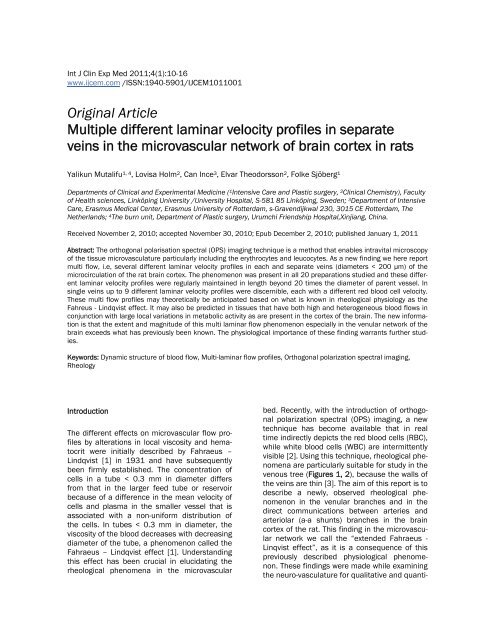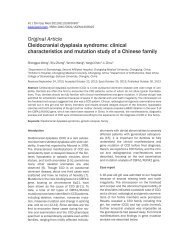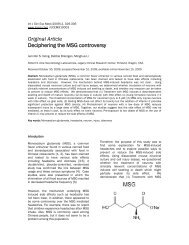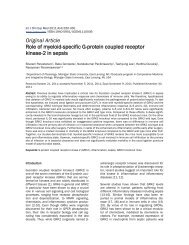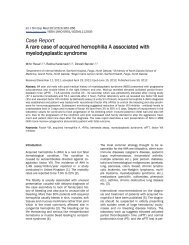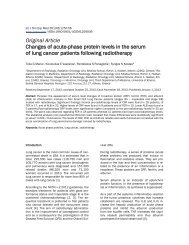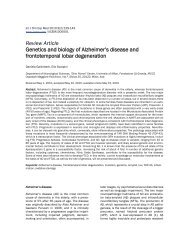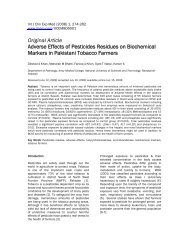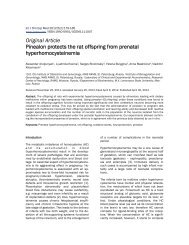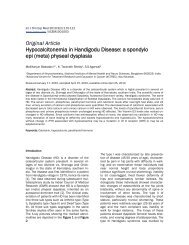Multiple different laminar velocity profiles in separate veins in the ...
Multiple different laminar velocity profiles in separate veins in the ...
Multiple different laminar velocity profiles in separate veins in the ...
Create successful ePaper yourself
Turn your PDF publications into a flip-book with our unique Google optimized e-Paper software.
Int J Cl<strong>in</strong> Exp Med 2011;4(1):10-16<br />
www.ijcem.com /ISSN:1940-5901/IJCEM1011001<br />
Orig<strong>in</strong>al Article<br />
<strong>Multiple</strong> <strong>different</strong> <strong>lam<strong>in</strong>ar</strong> <strong>velocity</strong> <strong>profiles</strong> <strong>in</strong> <strong>separate</strong><br />
ve<strong>in</strong>s <strong>in</strong> <strong>the</strong> microvascular network of bra<strong>in</strong> cortex <strong>in</strong> rats<br />
Yalikun Mutalifu 1, 4 , Lovisa Holm 2 , Can Ince 3 , Elvar Theodorsson 2 , Folke Sjöberg 1<br />
Departments of Cl<strong>in</strong>ical and Experimental Medic<strong>in</strong>e ( 1 Intensive Care and Plastic surgery, 2 Cl<strong>in</strong>ical Chemistry), Faculty<br />
of Health sciences, L<strong>in</strong>köp<strong>in</strong>g University /University Hospital, S-581 85 L<strong>in</strong>köp<strong>in</strong>g, Sweden; 3 Department of Intensive<br />
Care, Erasmus Medical Center, Erasmus University of Rotterdam, s-Gravendijkwal 230, 3015 CE Rotterdam, The<br />
Ne<strong>the</strong>rlands; 4 The burn unit, Department of Plastic surgery, Urumchi Friendship Hospital,X<strong>in</strong>jiang, Ch<strong>in</strong>a.<br />
Received November 2, 2010; accepted November 30, 2010; Epub December 2, 2010; published January 1, 2011<br />
Abstract: The orthogonal polarisation spectral (OPS) imag<strong>in</strong>g technique is a method that enables <strong>in</strong>travital microscopy<br />
of <strong>the</strong> tissue microvasculature particularly <strong>in</strong>clud<strong>in</strong>g <strong>the</strong> erythrocytes and leucocytes. As a new f<strong>in</strong>d<strong>in</strong>g we here report<br />
multi flow, i.e, several <strong>different</strong> <strong>lam<strong>in</strong>ar</strong> <strong>velocity</strong> <strong>profiles</strong> <strong>in</strong> each and <strong>separate</strong> ve<strong>in</strong>s (diameters < 200 μm) of <strong>the</strong><br />
microcirculation of <strong>the</strong> rat bra<strong>in</strong> cortex. The phenomenon was present <strong>in</strong> all 20 preparations studied and <strong>the</strong>se <strong>different</strong><br />
<strong>lam<strong>in</strong>ar</strong> <strong>velocity</strong> <strong>profiles</strong> were regularly ma<strong>in</strong>ta<strong>in</strong>ed <strong>in</strong> length beyond 20 times <strong>the</strong> diameter of parent vessel. In<br />
s<strong>in</strong>gle ve<strong>in</strong>s up to 9 <strong>different</strong> <strong>lam<strong>in</strong>ar</strong> <strong>velocity</strong> <strong>profiles</strong> were discernible, each with a <strong>different</strong> red blood cell <strong>velocity</strong>.<br />
These multi flow <strong>profiles</strong> may <strong>the</strong>oretically be anticipated based on what is known <strong>in</strong> rheological physiology as <strong>the</strong><br />
Fahreus - L<strong>in</strong>dqvist effect. It may also be predicted <strong>in</strong> tissues that have both high and heterogeneous blood flows <strong>in</strong><br />
conjunction with large local variations <strong>in</strong> metabolic activity as are present <strong>in</strong> <strong>the</strong> cortex of <strong>the</strong> bra<strong>in</strong>. The new <strong>in</strong>formation<br />
is that <strong>the</strong> extent and magnitude of this multi <strong>lam<strong>in</strong>ar</strong> flow phenomenon especially <strong>in</strong> <strong>the</strong> venular network of <strong>the</strong><br />
bra<strong>in</strong> exceeds what has previously been known. The physiological importance of <strong>the</strong>se f<strong>in</strong>d<strong>in</strong>g warrants fur<strong>the</strong>r studies.<br />
Keywords: Dynamic structure of blood flow, Multi-<strong>lam<strong>in</strong>ar</strong> flow <strong>profiles</strong>, Orthogonal polarization spectral imag<strong>in</strong>g,<br />
Rheology<br />
Introduction<br />
The <strong>different</strong> effects on microvascular flow <strong>profiles</strong><br />
by alterations <strong>in</strong> local viscosity and hematocrit<br />
were <strong>in</strong>itially described by Fahraeus –<br />
L<strong>in</strong>dqvist [1] <strong>in</strong> 1931 and have subsequently<br />
been firmly established. The concentration of<br />
cells <strong>in</strong> a tube < 0.3 mm <strong>in</strong> diameter differs<br />
from that <strong>in</strong> <strong>the</strong> larger feed tube or reservoir<br />
because of a difference <strong>in</strong> <strong>the</strong> mean <strong>velocity</strong> of<br />
cells and plasma <strong>in</strong> <strong>the</strong> smaller vessel that is<br />
associated with a non-uniform distribution of<br />
<strong>the</strong> cells. In tubes < 0.3 mm <strong>in</strong> diameter, <strong>the</strong><br />
viscosity of <strong>the</strong> blood decreases with decreas<strong>in</strong>g<br />
diameter of <strong>the</strong> tube, a phenomenon called <strong>the</strong><br />
Fahraeus – L<strong>in</strong>dqvist effect [1]. Understand<strong>in</strong>g<br />
this effect has been crucial <strong>in</strong> elucidat<strong>in</strong>g <strong>the</strong><br />
rheological phenomena <strong>in</strong> <strong>the</strong> microvascular<br />
bed. Recently, with <strong>the</strong> <strong>in</strong>troduction of orthogonal<br />
polarization spectral (OPS) imag<strong>in</strong>g, a new<br />
technique has become available that <strong>in</strong> real<br />
time <strong>in</strong>directly depicts <strong>the</strong> red blood cells (RBC),<br />
while white blood cells (WBC) are <strong>in</strong>termittently<br />
visible [2]. Us<strong>in</strong>g this technique, rheological phenomena<br />
are particularly suitable for study <strong>in</strong> <strong>the</strong><br />
venous tree (Figures 1, 2), because <strong>the</strong> walls of<br />
<strong>the</strong> ve<strong>in</strong>s are th<strong>in</strong> [3]. The aim of this report is to<br />
describe a newly, observed rheological phenomenon<br />
<strong>in</strong> <strong>the</strong> venular branches and <strong>in</strong> <strong>the</strong><br />
direct communications between arteries and<br />
arteriolar (a-a shunts) branches <strong>in</strong> <strong>the</strong> bra<strong>in</strong><br />
cortex of <strong>the</strong> rat. This f<strong>in</strong>d<strong>in</strong>g <strong>in</strong> <strong>the</strong> microvascular<br />
network we call <strong>the</strong> “extended Fahraeus -<br />
L<strong>in</strong>qvist effect”, as it is a consequence of this<br />
previously described physiological phenomenon.<br />
These f<strong>in</strong>d<strong>in</strong>gs were made while exam<strong>in</strong><strong>in</strong>g<br />
<strong>the</strong> neuro-vasculature for qualitative and quanti-
Lam<strong>in</strong>ar <strong>velocity</strong> <strong>in</strong> microvascular network of bra<strong>in</strong><br />
tative differences <strong>in</strong> <strong>the</strong> microvascular response<br />
to <strong>in</strong>flammation that are known to be prevalent<br />
<strong>in</strong> <strong>the</strong> bra<strong>in</strong> [4] and that are known to be <strong>different</strong><br />
to that seen <strong>in</strong> o<strong>the</strong>r organs such as <strong>the</strong><br />
liver, skeletal muscle, and mesentery [5-8]; differences<br />
that have led to a new evolv<strong>in</strong>g paradigm<br />
for blood cell-endo<strong>the</strong>lial cell <strong>in</strong>teraction <strong>in</strong><br />
this organ [4].<br />
Figure 1. OPS image of <strong>the</strong> bra<strong>in</strong> microvasculature <strong>in</strong><br />
<strong>the</strong> surface tissue after open<strong>in</strong>g of <strong>the</strong> dura. Central<br />
<strong>in</strong> <strong>the</strong> image is a larger venule (V) and <strong>the</strong> artery (A).<br />
Arrows <strong>in</strong>dicate flow direction (large (V) and small<br />
venule). The Bar corresponds to 100 µm. In <strong>the</strong> center<br />
of <strong>the</strong> larger venule, <strong>the</strong>re is a white streak <strong>in</strong>dicat<strong>in</strong>g<br />
<strong>the</strong> border between <strong>the</strong> two <strong>lam<strong>in</strong>ar</strong> flow <strong>profiles</strong><br />
generated by <strong>the</strong> two ve<strong>in</strong>s merg<strong>in</strong>g at <strong>the</strong> top of<br />
<strong>the</strong> image. In <strong>the</strong> left lower corner yet a third venule<br />
is jo<strong>in</strong><strong>in</strong>g and <strong>the</strong>reby add<strong>in</strong>g a third <strong>lam<strong>in</strong>ar</strong> flow<br />
profile.<br />
Material and methods<br />
Animal experiment<br />
Twenty female rats (Sprague-Dawley, B&K Universal,<br />
Sollentuna, Sweden) weigh<strong>in</strong>g from 250<br />
to 270g were used. The rats were housed two to<br />
a cage at a constant room temperature (21°C)<br />
for 3 days before operation, with free access to<br />
water and standard rat chow, and with 12-hour<br />
light/dark cycles.<br />
Anaes<strong>the</strong>sia was <strong>in</strong>duced with 4 % isoflurane<br />
(Forene ® 250ml, Abbott, Scand<strong>in</strong>avia AB, Kista,<br />
Sweden) <strong>in</strong> a mixture (30%:70%) of oxygen:nitrous<br />
oxide <strong>in</strong> a specially designed box. A<br />
soft endotracheal tube was used for controlled<br />
ventilation (Zoovent, CWC600AP), ULV, Newport,<br />
UK) us<strong>in</strong>g 1% isoflurane <strong>in</strong> a mixture<br />
(30%:70%) of oxygen:nitrous oxide. The tidal<br />
volume and ventilation frequency were carefully<br />
regulated us<strong>in</strong>g on-site monitor<strong>in</strong>g of blood<br />
gases and acid/base status (AVL, OPTI 1 Medical<br />
Nordic AB, Stockholm, Sweden). A longact<strong>in</strong>g<br />
non-steroidal anti-<strong>in</strong>flammatory, carpofen<br />
(Rimadyl ® , Pfizer, Dundee, Scotland) 0.1ml/kg<br />
was given at <strong>the</strong> beg<strong>in</strong>n<strong>in</strong>g of <strong>the</strong> operation [9].<br />
Microvascular preparation of <strong>the</strong> bra<strong>in</strong><br />
A bone flap (0.5 × 0.5 cm²) created <strong>in</strong> <strong>the</strong><br />
bregma region of rat’s temporal bone along <strong>the</strong><br />
sagittal suture was removed and <strong>the</strong> dura<br />
opened. A small volume was isolated on <strong>the</strong><br />
Figure 2. Schematic draw<strong>in</strong>g of <strong>the</strong> multi <strong>lam<strong>in</strong>ar</strong> flow <strong>profiles</strong>, generated by <strong>the</strong> add-on of each and more venular<br />
vessels <strong>in</strong> <strong>the</strong> microvascular bed of <strong>the</strong> bra<strong>in</strong>. In <strong>the</strong> illustration, <strong>the</strong> blood corpuscles from <strong>the</strong> branch vessels (c) and<br />
(b) do not mix/comb<strong>in</strong>e after flow<strong>in</strong>g <strong>in</strong>to a larger ve<strong>in</strong> (a), and cont<strong>in</strong>ued to travel <strong>separate</strong>ly even after reach<strong>in</strong>g <strong>the</strong><br />
second ma<strong>in</strong> branch<strong>in</strong>g vessel (d). In this vessel (d), four <strong>separate</strong> <strong>lam<strong>in</strong>ar</strong> flows with <strong>different</strong> flow velocities are discernible.<br />
11 Int J Cl<strong>in</strong> Exp Med 2011;4(1):10-16
Lam<strong>in</strong>ar <strong>velocity</strong> <strong>in</strong> microvascular network of bra<strong>in</strong><br />
bra<strong>in</strong> cortex with a r<strong>in</strong>g of silicone grease on to<br />
which a th<strong>in</strong> quadratic glass piece had been<br />
applied after <strong>the</strong> volume had been filled by<br />
warm Krebs’ solution. The microvascular bed<br />
was assessed through <strong>the</strong> glass with <strong>the</strong> OPS<br />
imag<strong>in</strong>g technique as described below. We<br />
searched for a visual field that conta<strong>in</strong>ed at<br />
least two venular networks, each of which conta<strong>in</strong>ed<br />
more than six <strong>separate</strong> areas <strong>in</strong> which<br />
venules were depicted clearly. All measurements<br />
were recorded cont<strong>in</strong>uously three times,<br />
each for five m<strong>in</strong>utes. We exam<strong>in</strong>ed microvascular<br />
networks that conta<strong>in</strong>ed vessels with <strong>the</strong><br />
follow<strong>in</strong>g diameters: arterioles rang<strong>in</strong>g from 20<br />
to 60 μm, and venules rang<strong>in</strong>g from 20 to 150<br />
μm. The study<strong>in</strong>g of complete microvascular<br />
networks also provides <strong>in</strong>formation that cannot<br />
be obta<strong>in</strong>ed from analysis of randomly selected<br />
vessels [10].<br />
Ortogonal Polarisation Spectral Imag<strong>in</strong>g (OPS)<br />
The orthogonal polarisation spectral (OPS) imag<strong>in</strong>g<br />
technique is a new way of imag<strong>in</strong>g <strong>the</strong><br />
microcirculation us<strong>in</strong>g reflected light that allows<br />
imag<strong>in</strong>g of <strong>the</strong> microcirculation non-<strong>in</strong>vasively<br />
through mucous membranes and on <strong>the</strong> surface<br />
of solid organs [11]. It even enables non<strong>in</strong>vasive<br />
visualization of <strong>the</strong> microvascular bed<br />
<strong>in</strong> humans. As it specifically depicts <strong>the</strong> <strong>separate</strong><br />
blood corpuscles it may be used to assess<br />
Figure 3. Screen picture (OPS image) of <strong>the</strong> bra<strong>in</strong><br />
microvascular bed (3 Venules). Relative <strong>velocity</strong> estimates<br />
are provided from <strong>the</strong> area (red box) positioned<br />
on <strong>the</strong> large venule <strong>in</strong> <strong>the</strong> center of <strong>the</strong> image.<br />
The correspond<strong>in</strong>g relative blood cell <strong>velocity</strong> is pictured<br />
to <strong>the</strong> left <strong>in</strong> <strong>the</strong> image (black rectangle with a<br />
white l<strong>in</strong>e). In <strong>the</strong> <strong>velocity</strong> profile of this box three<br />
<strong>separate</strong> flow maximums are depicted and marked<br />
with <strong>the</strong> correspond<strong>in</strong>g part of <strong>the</strong> vessel <strong>in</strong> <strong>the</strong> microvascular<br />
image (3 arrows). The relative flow profile<br />
was computed us<strong>in</strong>g KK-Technology software.<br />
<strong>the</strong> local vessel hematocrit and blood corpuscular<br />
<strong>velocity</strong> and so provide <strong>in</strong>direct <strong>in</strong>formation<br />
on local rheological phenomena.<br />
The OPS imag<strong>in</strong>g device used was a Cytoscan<br />
Model E-II (Cytometrics Inc., Philadelphia, Pa.,<br />
USA), a newly developed <strong>in</strong>strument that functions<br />
as an <strong>in</strong>travital microscope and is small<br />
and easily portable. By <strong>the</strong> use of orthogonal<br />
polarization spectral (OPS) imag<strong>in</strong>g, <strong>the</strong> Cytoscan<br />
Model E-II delivers images of <strong>the</strong> microcirculation<br />
that are comparable to those achieved<br />
with <strong>in</strong>travital fluorescence video microscopy<br />
(IFM), but without <strong>the</strong> use of fluorescent dyes<br />
[12]. Arterioles, venules, and capillaries can be<br />
<strong>in</strong>directly seen, and <strong>the</strong> movement of <strong>in</strong>dividual<br />
red blood cells can be observed through <strong>the</strong>m<br />
[13].<br />
Data analysis<br />
The images recorded of <strong>the</strong> microvascular beds<br />
were stored on DVD discs. The dimensions of<br />
<strong>the</strong> microvascular bed were assessed by specially<br />
designed software (KK-Technology, Sweet<strong>in</strong>g<br />
House, EX14 1LJ, England). Us<strong>in</strong>g this software<br />
<strong>the</strong> red cell <strong>velocity</strong> profile of a given vessel<br />
may also be depicted (Figure 3).<br />
Results<br />
Venular network<br />
The alterations <strong>in</strong> hematocrit seen for <strong>separate</strong><br />
ve<strong>in</strong>s – that is a central concentration and<br />
plasma skimm<strong>in</strong>g at <strong>the</strong> vascular wall effect<br />
was observed <strong>in</strong> all preparations (n=20), of<br />
which 15 such venular preparations are shown<br />
(Figure 4). Depend<strong>in</strong>g on <strong>the</strong> number of venular<br />
branches that jo<strong>in</strong>ed to form a larger vessel, a<br />
correspond<strong>in</strong>g number of <strong>different</strong> <strong>lam<strong>in</strong>ar</strong> flow<br />
<strong>profiles</strong> were seen. The multi <strong>lam<strong>in</strong>ar</strong> flow effect<br />
of any given ve<strong>in</strong> was ma<strong>in</strong>ta<strong>in</strong>ed for an extended<br />
length beyond <strong>the</strong> po<strong>in</strong>t where new vessels<br />
had jo<strong>in</strong>ed and new <strong>lam<strong>in</strong>ar</strong> flow <strong>profiles</strong><br />
were added. These <strong>profiles</strong> were ma<strong>in</strong>ta<strong>in</strong>ed<br />
from 2 to 9 venular vessels, each <strong>in</strong> <strong>the</strong>mselves<br />
add<strong>in</strong>g a new <strong>lam<strong>in</strong>ar</strong> flow profile (Figure 5).<br />
These <strong>separate</strong> flow <strong>profiles</strong> were also kept well<br />
beyond a distance longer than that of 20 diameters<br />
of <strong>the</strong> parent vessel (Figure 6). When <strong>the</strong><br />
dimension of a vessel was chang<strong>in</strong>g, this also<br />
affected <strong>the</strong> width of <strong>the</strong> <strong>lam<strong>in</strong>ar</strong> flow profile <strong>in</strong><br />
that vessel, which changed accord<strong>in</strong>gly. The<br />
profile varied over time <strong>in</strong> parallel to pulsations<br />
12 Int J Cl<strong>in</strong> Exp Med 2011;4(1):10-16
Lam<strong>in</strong>ar <strong>velocity</strong> <strong>in</strong> microvascular network of bra<strong>in</strong><br />
Figure 4. OPS imag<strong>in</strong>g show<strong>in</strong>g <strong>the</strong> venular network <strong>in</strong> <strong>the</strong> microvascular preparation of <strong>the</strong> bra<strong>in</strong>. The phenomenon<br />
with ma<strong>in</strong>ta<strong>in</strong>ed multi <strong>lam<strong>in</strong>ar</strong> flow profile effects was recorded <strong>in</strong> all 20 animal preparations, here show<strong>in</strong>g 15 of<br />
<strong>the</strong>m. Calibration bar is 50 µm; (V) venule; arrows <strong>in</strong>dicate flow directions; Arterioles (A). Visualizations were by <strong>the</strong><br />
CYTOSCAN E-II device with x 10 lens.<br />
Figure 5. Depend<strong>in</strong>g on <strong>the</strong> number of venules jo<strong>in</strong><strong>in</strong>g<br />
to form a larger vessel (center of image), <strong>the</strong>re is a<br />
correspond<strong>in</strong>g number of flow <strong>profiles</strong>. For each vessel<br />
<strong>the</strong> number of <strong>lam<strong>in</strong>ar</strong> blood flow patterns visible<br />
is depicted (black text). In this preparation more than<br />
8 <strong>separate</strong> <strong>lam<strong>in</strong>ar</strong> flow <strong>profiles</strong> were discernible<br />
when <strong>the</strong> large vessel was formed and that exits <strong>the</strong><br />
image to <strong>the</strong> lower right. Bar <strong>in</strong>dicate 100 µm.<br />
or effects of ventilation (Figure 7). When <strong>different</strong><br />
<strong>lam<strong>in</strong>ar</strong> flow <strong>profiles</strong> were exam<strong>in</strong>ed, it was<br />
Figure 6. The <strong>lam<strong>in</strong>ar</strong> blood flow <strong>profiles</strong> generated<br />
from <strong>the</strong> venule marked with an arrow (diameter 9.9<br />
µm) as it is jo<strong>in</strong><strong>in</strong>g <strong>the</strong> larger venule (with its 4 <strong>lam<strong>in</strong>ar</strong><br />
flows (Flow direction and arrow)) <strong>the</strong> length of<br />
<strong>the</strong> ma<strong>in</strong>ta<strong>in</strong>ed flow profile is at least 215.8 µm, also<br />
marked with an arrow. A-a <strong>in</strong>dicates arterial – arterial<br />
anastomoses. Bar corresponds to 100 µm.<br />
evident that each of <strong>the</strong>se <strong>profiles</strong> depicted a<br />
<strong>different</strong> blood cell <strong>velocity</strong> (Figure 3). This was<br />
also clearly evident by just exam<strong>in</strong><strong>in</strong>g <strong>the</strong><br />
smaller dimension vessels <strong>in</strong> <strong>the</strong> OPS system.<br />
13 Int J Cl<strong>in</strong> Exp Med 2011;4(1):10-16
Lam<strong>in</strong>ar <strong>velocity</strong> <strong>in</strong> microvascular network of bra<strong>in</strong><br />
Figure 7. The multi <strong>lam<strong>in</strong>ar</strong> flow <strong>profiles</strong> are ma<strong>in</strong>ta<strong>in</strong>ed dur<strong>in</strong>g tissue pulsations due to arterial pulse pressure<br />
changes and changes due to respiration. In this image a smaller arteriole (A) is cross<strong>in</strong>g larger venule (V). The width<br />
of <strong>the</strong> <strong>lam<strong>in</strong>ar</strong> profile is <strong>in</strong>creas<strong>in</strong>g from image A (left) to B (center; an image frame 12 seconds later) and aga<strong>in</strong><br />
smaller image C (right; an image frame 16 seconds after <strong>the</strong> first image). Arrow <strong>in</strong>dicates flow direction. Bar corresponds<br />
to 100 µm.<br />
<strong>the</strong> present preparation (rat bra<strong>in</strong>) has not, to<br />
our knowledge been described previously.<br />
The f<strong>in</strong>d<strong>in</strong>gs suggest that <strong>the</strong> consequence of<br />
<strong>the</strong> Fahraeus-L<strong>in</strong>dqvist effect is more extensive<br />
<strong>in</strong> <strong>the</strong> bra<strong>in</strong> venular microvascular bed than<br />
previously known. The f<strong>in</strong>d<strong>in</strong>g, which we have<br />
called “multi <strong>lam<strong>in</strong>ar</strong> <strong>velocity</strong> flow <strong>profiles</strong>” is<br />
that <strong>in</strong> <strong>the</strong> microvasculature <strong>the</strong> blood corpuscles<br />
do not mix when two vessels meet, but <strong>the</strong><br />
concentration and its distribution of red cells<br />
that corresponds to <strong>the</strong> diameter of <strong>the</strong> parent<br />
vessel is ma<strong>in</strong>ta<strong>in</strong>ed, and that <strong>the</strong> plasma skimm<strong>in</strong>g<br />
at <strong>the</strong> vessel border is also kept after several<br />
new venular vessels have jo<strong>in</strong>ed.<br />
Figure 8. The direct communication observed between<br />
two arteriole (a-a shunts) <strong>in</strong> <strong>the</strong> rat bra<strong>in</strong>. Arrow<br />
<strong>in</strong>dicates flow direction. Also <strong>in</strong> <strong>the</strong> a-a conection<br />
<strong>the</strong> <strong>lam<strong>in</strong>ar</strong> flow <strong>profiles</strong> are ma<strong>in</strong>ta<strong>in</strong>ed. Bar marks<br />
100 µm.<br />
Arteriolar network<br />
We observed arteriolar (a-a shunts) regularly <strong>in</strong><br />
<strong>the</strong> preparation of <strong>the</strong> cortex. In <strong>the</strong>se a-a<br />
shunts, double parabolic flow <strong>profiles</strong> were also<br />
seen (Figure 8).<br />
Discussion<br />
We describe extensive multi <strong>lam<strong>in</strong>ar</strong> flow <strong>profiles</strong><br />
<strong>in</strong> <strong>separate</strong> ve<strong>in</strong>s of <strong>the</strong> bra<strong>in</strong> microcirculation<br />
that lasted more than 20 vessel diameters<br />
<strong>in</strong> <strong>the</strong> venular microcirculation. To our knowledge,<br />
although <strong>the</strong> phenomenon may be predicted<br />
by <strong>the</strong> effects described by Fahreus-<br />
L<strong>in</strong>dquist [14], <strong>the</strong> extent of this phenomenon <strong>in</strong><br />
The f<strong>in</strong>d<strong>in</strong>g was appreciated <strong>in</strong> all of <strong>the</strong> preparations<br />
of <strong>the</strong> bra<strong>in</strong> cortex that we exam<strong>in</strong>ed<br />
and was most prevalent for <strong>the</strong> venular network,<br />
though similar changes were also seen on<br />
<strong>the</strong> arterial side. We have been unable to f<strong>in</strong>d<br />
publications that have described such f<strong>in</strong>d<strong>in</strong>gs,<br />
except <strong>in</strong> an experimental series done dur<strong>in</strong>g<br />
severe hemodilution, <strong>in</strong> which a similar but<br />
lesser effect was noted [15]. Of importance is<br />
that we also noted that <strong>the</strong> red cell <strong>velocity</strong><br />
seemed to be highest <strong>in</strong> <strong>the</strong> centerl<strong>in</strong>e of each<br />
<strong>lam<strong>in</strong>ar</strong> flow profile as has previously been described<br />
for s<strong>in</strong>gle vessels [16].<br />
Although we have exam<strong>in</strong>ed only <strong>the</strong> microcirculation<br />
of <strong>the</strong> bra<strong>in</strong> cortex it is possible that this<br />
phenomenon, albeit less extensive, may also be<br />
present <strong>in</strong> more venular microvascular beds of<br />
o<strong>the</strong>r organs. The f<strong>in</strong>d<strong>in</strong>g may, however, be particularly<br />
prevalent <strong>in</strong> <strong>the</strong> cortex of <strong>the</strong> bra<strong>in</strong> for<br />
several reasons: first and most importantly <strong>the</strong><br />
high, and locally vary<strong>in</strong>g cell metabolism of <strong>the</strong><br />
bra<strong>in</strong> leads to local variations <strong>in</strong> metabolic<br />
needs and co-existent microvascular flow; secondly,<br />
<strong>the</strong> high flow <strong>in</strong> this organ leads to high<br />
14 Int J Cl<strong>in</strong> Exp Med 2011;4(1):10-16
Lam<strong>in</strong>ar <strong>velocity</strong> <strong>in</strong> microvascular network of bra<strong>in</strong><br />
blood cell <strong>velocity</strong>, which if it is <strong>different</strong>, counteracts<br />
mix<strong>in</strong>g of blood corpuscles [17]; thirdly,<br />
<strong>the</strong> high vessel density <strong>in</strong> this tissue may contribute<br />
fur<strong>the</strong>r to <strong>the</strong> phenomenon.<br />
One physiologically important consequence of<br />
<strong>the</strong> described phenomenon is that it, although<br />
we did not specifically exam<strong>in</strong>e this <strong>in</strong> <strong>the</strong> present<br />
paper, may affect <strong>the</strong> process of extravasation<br />
of <strong>the</strong> WBC and <strong>the</strong> exchange of molecules<br />
<strong>in</strong>clud<strong>in</strong>g oxygen and carbon dioxide between<br />
erythrocytes and <strong>the</strong> tissues, and <strong>the</strong>reby also<br />
have consequences for <strong>the</strong> <strong>in</strong>flammatory process.<br />
This is currently of particular importance as<br />
<strong>the</strong>re has been an evolv<strong>in</strong>g new description of<br />
<strong>the</strong> blood cell-endo<strong>the</strong>lial cell <strong>in</strong>teractions <strong>in</strong> <strong>the</strong><br />
cerebral circulation [4]. There is evidence that<br />
suggests that <strong>the</strong>re are qualitative and quantitative<br />
differences <strong>in</strong> <strong>the</strong> microvascular response<br />
to <strong>in</strong>flammation <strong>in</strong> <strong>the</strong> bra<strong>in</strong> compared with<br />
o<strong>the</strong>r organs such as liver, skeletal muscle and<br />
mesentery [4]. The cerebrovascular endo<strong>the</strong>lial<br />
cells have a number of unique characteristics,<br />
<strong>in</strong>clud<strong>in</strong>g <strong>the</strong>ir barrier, transport, metabolic, and<br />
cell traffik<strong>in</strong>g properties. These differences may<br />
also depend on a <strong>different</strong> underly<strong>in</strong>g rheology.<br />
The multi <strong>lam<strong>in</strong>ar</strong> blood flow <strong>profiles</strong> that have<br />
been described would <strong>the</strong>oretically lead to a<br />
decreased extravasation of WBC´s as <strong>the</strong>y<br />
would make traffick<strong>in</strong>g even more difficult. Such<br />
effects may for example, emphasize <strong>the</strong> f<strong>in</strong>d<strong>in</strong>g<br />
of few WBC <strong>in</strong> <strong>the</strong> bra<strong>in</strong> parenchyma, which has<br />
led to <strong>the</strong> claim that <strong>the</strong> bra<strong>in</strong> is an immunologically<br />
privileged organ [4]. The rheological state<br />
described, multi <strong>lam<strong>in</strong>ar</strong> flow <strong>profiles</strong>, may fur<strong>the</strong>r<br />
contribute to difficulties for <strong>the</strong> WBC to extra-vasate.<br />
For example <strong>the</strong> WBC extravasation<br />
<strong>in</strong> <strong>the</strong> bra<strong>in</strong> is claimed to be less than 1:20 of<br />
that seen <strong>in</strong> <strong>the</strong> skeletal muscle [18]. This f<strong>in</strong>d<strong>in</strong>g<br />
has previously been described and claimed<br />
to be <strong>the</strong> result of several factors such as: low<br />
basal expression of endo<strong>the</strong>lial cell adhesion<br />
molecules [18]; a high electrostatic charge on<br />
<strong>the</strong> cerebrovascular endo<strong>the</strong>lial cells [19]; and<br />
high venular shear rates that tend to oppose<br />
adhesion of blood cells [8]. Added to <strong>the</strong>se factors<br />
may also be <strong>the</strong> multi <strong>lam<strong>in</strong>ar</strong> blood flow<br />
profile effect described here and this needs to<br />
be fur<strong>the</strong>r exam<strong>in</strong>ed and confirmed <strong>in</strong> future<br />
studies.<br />
An important contribut<strong>in</strong>g factor that has led to<br />
<strong>the</strong> presented f<strong>in</strong>d<strong>in</strong>gs is <strong>the</strong> use of a new imag<strong>in</strong>g<br />
technique (OPS). We th<strong>in</strong>k that <strong>the</strong> specifics<br />
of this technique provide <strong>the</strong> technical background<br />
to picture local variations <strong>in</strong> hematocrit<br />
more easily. OPS is based on that <strong>the</strong> polarized<br />
light is absorbed by <strong>the</strong> red blood corpuscles<br />
and <strong>the</strong> red blood cells are seen as dark images.<br />
The correspond<strong>in</strong>g layers of plasma skimm<strong>in</strong>g<br />
do not absorb <strong>the</strong> light and are depicted <strong>in</strong><br />
<strong>the</strong> video images as white streaks that enable<br />
<strong>the</strong> observer to dist<strong>in</strong>guish <strong>the</strong>m from <strong>the</strong> mass<br />
of red cells [20]. That comb<strong>in</strong>ed with <strong>the</strong> th<strong>in</strong><br />
layer of <strong>the</strong> venular wall, facilitates <strong>the</strong> observation<br />
of vary<strong>in</strong>g local vessel hematocrit. The<br />
lower blood cell <strong>velocity</strong> <strong>in</strong> <strong>the</strong> ve<strong>in</strong>s fur<strong>the</strong>r amplifies<br />
<strong>the</strong> discrim<strong>in</strong>ative power of <strong>the</strong> <strong>in</strong>vestigator.<br />
Apart from <strong>the</strong> fact that <strong>the</strong>y are less prevalent,<br />
it was more difficult technically to f<strong>in</strong>d correspond<strong>in</strong>g<br />
phenomena <strong>in</strong> <strong>the</strong> arterial tree. This<br />
may be partly due to <strong>the</strong> difficulty of OPS light<br />
penetration through <strong>the</strong> arterial wall, and <strong>the</strong><br />
higher blood cell <strong>velocity</strong> <strong>in</strong> <strong>the</strong>se vessels. Arterial<br />
to arterial branch<strong>in</strong>g was also less redundant.<br />
The underly<strong>in</strong>g mechanisms for <strong>the</strong>se rheological<br />
f<strong>in</strong>d<strong>in</strong>gs is that <strong>the</strong> resistance to flow is less<br />
<strong>in</strong> <strong>the</strong> areas of <strong>the</strong> vessel border, which leads to<br />
a central concentration of <strong>the</strong> red blood cells,<br />
and simultaneously plasma is marg<strong>in</strong>alized at<br />
<strong>the</strong> endo<strong>the</strong>lial end. The underly<strong>in</strong>g rheological<br />
physiology also leads to a <strong>velocity</strong> <strong>in</strong>crease of<br />
<strong>the</strong> red cells at <strong>the</strong> central core of <strong>the</strong> vessel.<br />
As <strong>the</strong> blood cells are affected by <strong>the</strong> <strong>in</strong>creas<strong>in</strong>g<br />
speed at <strong>the</strong> center, forces are liberated that<br />
tend to rotate <strong>the</strong> blood cell and fur<strong>the</strong>r facilitate<br />
<strong>the</strong> migration of <strong>the</strong> red blood corpuscle<br />
towards <strong>the</strong> center l<strong>in</strong>e [21, 22].<br />
Ano<strong>the</strong>r important factor that contributes to <strong>the</strong><br />
f<strong>in</strong>d<strong>in</strong>gs of <strong>the</strong> present study is <strong>the</strong> use of a validated<br />
animal model. This model is based on<br />
<strong>in</strong>halation anes<strong>the</strong>sia, and special care was<br />
taken not to alter <strong>the</strong> circulatory or ventilatory<br />
sett<strong>in</strong>gs once <strong>the</strong> preparation was stable [9].<br />
Us<strong>in</strong>g a from environmental high oxygen and<br />
low carbon dioxide closed microvascular preparation<br />
also reduces any effects of <strong>the</strong> atmospheric<br />
gases, particularly vasoconstriction <strong>in</strong>duced<br />
by a low carbon dioxide, which are known<br />
to affect <strong>the</strong> microvascular preparations and<br />
alter microvascular rheology [23].<br />
In summary we have shown that multi <strong>lam<strong>in</strong>ar</strong><br />
flow <strong>profiles</strong> are common phenomena <strong>in</strong> <strong>the</strong><br />
venous microvasculature of <strong>the</strong> rat bra<strong>in</strong>. The<br />
f<strong>in</strong>d<strong>in</strong>gs may be expla<strong>in</strong>ed by <strong>the</strong> high and heterogeneous<br />
metabolic rate and <strong>the</strong> complex<br />
15 Int J Cl<strong>in</strong> Exp Med 2011;4(1):10-16
Lam<strong>in</strong>ar <strong>velocity</strong> <strong>in</strong> microvascular network of bra<strong>in</strong><br />
microvascular architecture of <strong>the</strong> bra<strong>in</strong>. Contribut<strong>in</strong>g<br />
factors to <strong>the</strong>se f<strong>in</strong>d<strong>in</strong>gs are also <strong>the</strong> specifics<br />
of <strong>the</strong> OPS imag<strong>in</strong>g system, which clearly<br />
visualizes <strong>the</strong> red corpuscles <strong>in</strong> <strong>the</strong> microvasculature<br />
and so <strong>in</strong>creases <strong>the</strong> chances of observ<strong>in</strong>g<br />
rheological phenomena. The physiological<br />
relevance of <strong>the</strong> multi <strong>lam<strong>in</strong>ar</strong> flow <strong>profiles</strong> is<br />
unclear. However, it may be of importance for<br />
<strong>the</strong> extravasation of WBC, and as such have<br />
implications for <strong>the</strong> <strong>in</strong>flammatory process <strong>in</strong> <strong>the</strong><br />
bra<strong>in</strong>, however this needs fur<strong>the</strong>r <strong>in</strong>vestigations<br />
Please address correspondence to: Folke Sjöberg,<br />
MD, PhD, Deptartment of Hand and Plastic Surgery<br />
and Intensive care, L<strong>in</strong>köp<strong>in</strong>g University Hospital,<br />
581 85 L<strong>in</strong>köp<strong>in</strong>g, Sweden. Tel: 46 13 22 1820, Fax:<br />
+46 13 22 2836, E-mail: folsj@ibk.liu.se<br />
References<br />
[1] Beck MR, Jr., Eckste<strong>in</strong> EC: Prelim<strong>in</strong>ary report on<br />
platelet concentration <strong>in</strong> capillary tube flows of<br />
whole blood. Biorheology 1980, 17:455-464.<br />
[2] Nadeau RG, Groner W: The role of a new non<strong>in</strong>vasive<br />
imag<strong>in</strong>g technology <strong>in</strong> <strong>the</strong> diagnosis of<br />
anemia. J Nutr 2001, 131:1610S-1614S.<br />
[3] Ibukuro K, Tsukiyama T, Mori K, Inoue Y: Peripancreatic<br />
ve<strong>in</strong>s on th<strong>in</strong>-section (3 mm) helical<br />
CT. AJR Am J Roentgenol 1996, 167:1003-<br />
1008.<br />
[4] Gav<strong>in</strong>s F, Yilmaz G, Granger DN: The evolv<strong>in</strong>g<br />
paradigm for blood cell-endo<strong>the</strong>lial cell <strong>in</strong>teractions<br />
<strong>in</strong> <strong>the</strong> cerebral microcirculation. Microcirculation<br />
2007, 14:667-681.<br />
[5] Carvalho-Tavares J, Hickey MJ, Hutchison J,<br />
Michaud J, Sutcliffe IT, Kubes P: A role for platelets<br />
and endo<strong>the</strong>lial select<strong>in</strong>s <strong>in</strong> tumor necrosis<br />
factor-alpha-<strong>in</strong>duced leukocyte recruitment <strong>in</strong><br />
<strong>the</strong> bra<strong>in</strong> microvasculature. Circ Res 2000,<br />
87:1141-1148.<br />
[6] Eppihimer MJ, Wolitzky B, Anderson DC, Labow<br />
MA, Granger DN: Heterogeneity of expression of<br />
E- and P-select<strong>in</strong>s <strong>in</strong> vivo. Circ Res 1996, 79:560<br />
-569.<br />
[7] Henn<strong>in</strong>ger DD, Panes J, Eppihimer M, Russell J,<br />
Gerritsen M, Anderson DC, Granger DN: Cytok<strong>in</strong>e<br />
-<strong>in</strong>duced VCAM-1 and ICAM-1 expression <strong>in</strong> <strong>different</strong><br />
organs of <strong>the</strong> mouse. J Immunol 1997,<br />
158:1825-1832.<br />
[8] Liu L, Kubes P: Molecular mechanisms of leukocyte<br />
recruitment: organ-specific mechanisms of<br />
action. Thromb Haemost 2003, 89:213-220.<br />
[9] Theodorsson A, Holm L, Theodorsson E: Modern<br />
anes<strong>the</strong>sia and peroperative monitor<strong>in</strong>g methods<br />
reduce per- and postoperative mortality dur<strong>in</strong>g<br />
transient occlusion of <strong>the</strong> middle cerebral<br />
artery <strong>in</strong> rats. Bra<strong>in</strong> Res Bra<strong>in</strong> Res Protoc 2005,<br />
14:181-190.<br />
[10] Power RF, Conneely OM, O'Malley BW: New <strong>in</strong>sights<br />
<strong>in</strong>to activation of <strong>the</strong> steroid hormone<br />
receptor superfamily. Trends Pharmacol Sci<br />
1992, 13:318-323.<br />
[11] Groner W, W<strong>in</strong>kelman JW, Harris AG, Ince C,<br />
Bouma GJ, Messmer K, Nadeau RG: Orthogonal<br />
polarization spectral imag<strong>in</strong>g: a new method for<br />
study of <strong>the</strong> microcirculation. Nat Med 1999,<br />
5:1209-1212.<br />
[12] Harris AG, S<strong>in</strong>its<strong>in</strong>a I, Messmer K: The Cytoscan<br />
Model E-II, a new reflectance microscope for<br />
<strong>in</strong>travital microscopy: comparison with <strong>the</strong> standard<br />
fluorescence method. J Vasc Res 2000,<br />
37:469-476.<br />
[13] Chung S, Hazen A, Lev<strong>in</strong>e JP, Baux G, Olivier WA,<br />
Yee HT, Margiotta MS, Karp NS, Gurtner GC:<br />
Vascularized acellular dermal matrix island flaps<br />
for <strong>the</strong> repair of abdom<strong>in</strong>al muscle defects. Plast<br />
Reconstr Surg 2003, 111:225-232.<br />
[14] Fåhraeus R LT: The viscosity of <strong>the</strong> blood <strong>in</strong> narrow<br />
capillary tubes. Am J Physiol 1931, 96:562-<br />
568.<br />
[15] Ivanov KP, Levkovich Iu I: [Dynamic structure of<br />
blood flow <strong>in</strong> <strong>the</strong> smallest ve<strong>in</strong>s of <strong>the</strong> bra<strong>in</strong>].<br />
Biull Eksp Biol Med 1990, 109:8-11.<br />
[16] Re<strong>in</strong>ke W, Johnson PC, Gaehtgens P: Effect of<br />
shear rate variation on apparent viscosity of<br />
human blood <strong>in</strong> tubes of 29 to 94 microns diameter.<br />
Circ Res 1986, 59:124-132.<br />
[17] Villr<strong>in</strong>ger A, Them A, L<strong>in</strong>dauer U, E<strong>in</strong>haupl K,<br />
Dirnagl U: Capillary perfusion of <strong>the</strong> rat bra<strong>in</strong><br />
cortex. An <strong>in</strong> vivo confocal microscopy study. Circ<br />
Res 1994, 75:55-62.<br />
[18] Barkalow FJ, Goodman MJ, Gerritsen ME, Mayadas<br />
TN: Bra<strong>in</strong> endo<strong>the</strong>lium lack one of two<br />
pathways of P-select<strong>in</strong>-mediated neutrophil adhesion.<br />
Blood 1996, 88:4585-4593.<br />
[19] Dietrich JB: The adhesion molecule ICAM-1 and<br />
its regulation <strong>in</strong> relation with <strong>the</strong> blood-bra<strong>in</strong><br />
barrier. J Neuroimmunol 2002, 128:58-68.<br />
[20] Penn<strong>in</strong>gs FA, Bouma GJ, Ince C: Direct observation<br />
of <strong>the</strong> human cerebral microcirculation dur<strong>in</strong>g<br />
aneurysm surgery reveals <strong>in</strong>creased arteriolar<br />
contractility. Stroke 2004, 35:1284-1288.<br />
[21] Bishop JJ, Nance PR, Popel AS, Intaglietta M,<br />
Johnson PC: Erythrocyte marg<strong>in</strong>ation and sedimentation<br />
<strong>in</strong> skeletal muscle venules. Am J<br />
Physiol Heart Circ Physiol 2001, 281:H951-958.<br />
[22] L<strong>in</strong>dbom L, Tuma RF, Arfors KE: Influence of<br />
oxygen on perfused capillary density and capillary<br />
red cell <strong>velocity</strong> <strong>in</strong> rabbit skeletal muscle.<br />
Microvasc Res 1980, 19:197-208.<br />
16 Int J Cl<strong>in</strong> Exp Med 2011;4(1):10-16


